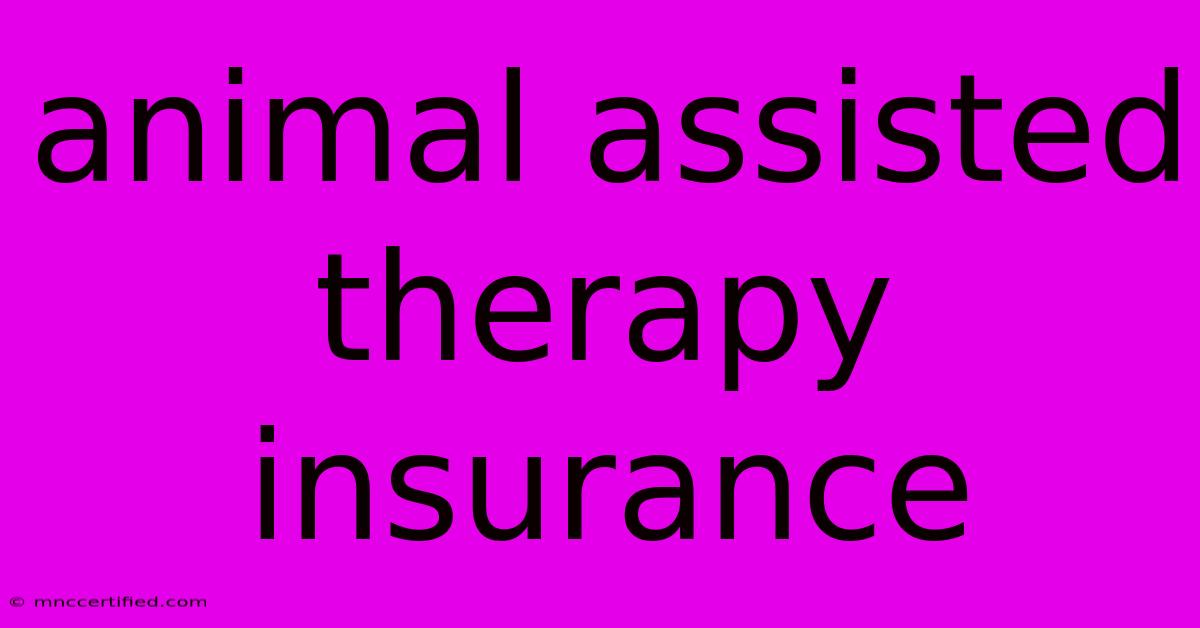Animal Assisted Therapy Insurance

Table of Contents
Animal Assisted Therapy Insurance: Navigating the Complexities of Coverage
Animal-assisted therapy (AAT) is increasingly recognized for its therapeutic benefits, providing comfort and support to individuals facing a wide range of challenges. From children with autism to veterans struggling with PTSD, the positive impact of interacting with animals is undeniable. However, the cost of AAT can be significant, leading many to wonder about animal assisted therapy insurance coverage. This comprehensive guide explores the complexities of insurance and AAT, helping you understand what to expect and how to navigate the system effectively.
Understanding the Landscape of Animal Assisted Therapy Insurance
Unfortunately, there's no simple yes or no answer to whether your insurance covers AAT. Coverage varies dramatically depending on several key factors:
- Your Insurance Provider: Different insurance companies have vastly different policies. Some may cover AAT as part of a broader mental health or physical therapy plan, while others may not offer any coverage at all. Checking your policy's specifics is crucial.
- Type of Therapy: The type of AAT being offered influences coverage. Is it provided by a licensed professional? Is it part of a structured program, or is it more informal? Insurance companies are more likely to cover formalized, clinically-driven AAT.
- Diagnosis: The reason for seeking AAT plays a significant role. Conditions such as PTSD, anxiety disorders, autism spectrum disorder, and depression are more likely to have coverage compared to less clinically recognized needs.
- Provider Credentials: Insurance companies often require that the AAT provider be licensed and qualified. Working with a credentialed therapist who can provide necessary documentation greatly increases the chances of successful claim processing.
What to Expect When Seeking Coverage
Before embarking on AAT, proactively contact your insurance provider to determine your coverage. You should inquire about:
- Specific coverage for animal-assisted therapy: Ask if AAT is covered under your current plan and if there are any limitations.
- Pre-authorization requirements: Many insurers require pre-authorization for certain therapies. This involves obtaining approval before starting treatment.
- Reimbursement policies: Understand the reimbursement process, including the required documentation and claim submission procedures.
- Network providers: Inquire if your chosen AAT provider is part of your insurance network. Using in-network providers can significantly reduce out-of-pocket expenses.
- Limitations on sessions: Find out the maximum number of sessions covered per year or lifetime.
Maximizing Your Chances of Animal Assisted Therapy Insurance Coverage
To increase your chances of successful insurance coverage for AAT, consider these strategies:
- Obtain a referral from your doctor or therapist: A referral from a healthcare professional strengthens your case and adds legitimacy to your claim.
- Choose a qualified and credentialed AAT provider: This significantly increases the likelihood of insurance approval. Look for professionals with relevant certifications and experience.
- Maintain detailed records: Keep thorough records of your AAT sessions, including dates, times, and the therapist's notes. These are vital for submitting a complete and accurate insurance claim.
- Understand your policy's terminology: Familiarize yourself with your insurance policy's language to identify relevant clauses pertaining to mental health or physical therapy that may encompass AAT.
- Appeal denied claims: If your claim is denied, understand your insurer's appeals process. Provide them with additional supporting documentation if necessary.
Exploring Alternatives When Insurance Coverage is Limited or Unavailable
If your insurance doesn't cover AAT, or if coverage is insufficient, several alternatives can help manage costs:
- Fundraising: Explore online crowdfunding platforms or organize local fundraising events to offset the expenses.
- Negotiating payment plans: Discuss payment options with your AAT provider. Many providers are willing to work with clients on flexible payment schedules.
- Seeking financial assistance: Research local charities or non-profit organizations that provide financial aid for therapeutic services.
Conclusion: Proactive Planning is Key
Navigating animal assisted therapy insurance can be challenging, but with proactive planning and a thorough understanding of your policy, you can significantly increase your chances of securing coverage. Remember that open communication with your insurance provider and AAT provider is crucial for a successful outcome. By understanding the nuances of insurance coverage and employing the strategies outlined above, you can access the powerful benefits of AAT while minimizing financial burdens.

Thank you for visiting our website wich cover about Animal Assisted Therapy Insurance. We hope the information provided has been useful to you. Feel free to contact us if you have any questions or need further assistance. See you next time and dont miss to bookmark.
Featured Posts
-
Aus Beat Pak 3rd T20 I Cricket Score
Nov 19, 2024
-
Chiefs Week Blood Drive Event
Nov 19, 2024
-
Brendan Carrs Fcc Appointment Effects
Nov 19, 2024
-
Daikin Park Astros New Stadium Name
Nov 19, 2024
-
Russia Warns Us About Ukraine Attacks
Nov 19, 2024